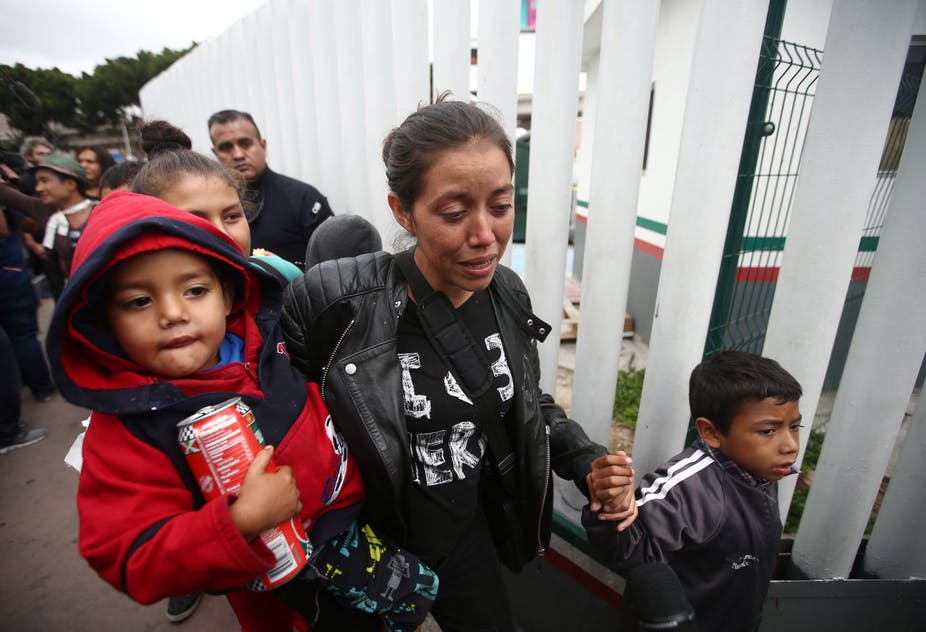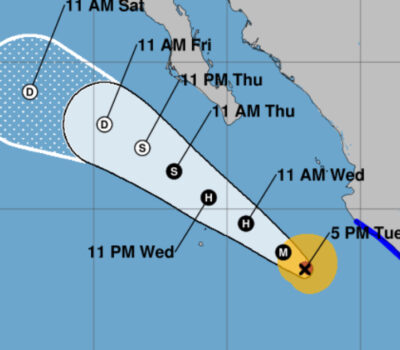The Central American migrants whose month-long journey northward across Mexico spurred President Donald Trump to attack them on Twitter have begun to enter the United States.
Some 1,500 Central Americans, most of them Hondurans, began their trip from Guatemala in early April. Traveling across Mexico by foot, train and bus, they moved together in caravan style for safety. Roughly 200 migrants stayed with the caravan until reaching the U.S.-Mexico border at Tijuana.
Central America is one of the most violent regions on the planet. The migrants planned to apply for asylum in the United States, but Trump tweeted that the group “better be stopped.”
The big Caravan of People from Honduras, now coming across Mexico and heading to our “Weak Laws” Border, had better be stopped before it gets there. Cash cow NAFTA is in play, as is foreign aid to Honduras and the countries that allow this to happen. Congress MUST ACT NOW!
— Donald J. Trump (@realDonaldTrump) April 3, 2018
After a week-long standoff at the San Ysidro border crossing, officials have now begun allowing some women and children to enter the country.
1. Who gets asylum?
Under international law, countries must offer asylum to migrants who can prove they have a “credible fear” of certain kinds of violence at home.
“The rights of refugees – those forced to leave their country because of war or persecution – are enshrined in the 1951 Convention for Refugees and its subsequent 1967 protocol,” explains Parvati Nair of the United Nations University.
The Trump administration asserts that the caravan members are not refugees but criminals committing immigration fraud.
The boundary between migrant and refugee can indeed be blurry, Nair says. “Many displaced people today defy the parameters used by policymakers to define who is entitled to what rights,” which are more than a half-century old.
2. Are Central Americans migrants or refugees?
Trump’s restrictive approach to immigration evidently hinges on a belief that most people crossing the border are economic migrants from Mexico.
“They’re taking our manufacturing jobs,” he said in 2015. “They’re taking our money.”
That perception is out of date, says Jonathan Hiskey, a migration scholar at Vanderbilt University.
“An increasing number of individuals are now arriving at the U.S. southwest border because of crime, violence and insecurity in Central America,” Hiskey says.
With 60 murders per 100,000 people in 2017, El Salvador was the deadliest places in the world that was not at war. Almost 4,000 people were killed there last year.
Honduras’ murder rate has dropped markedly in recent years, but with 42.8 murders per 100,000 people in 2017, it is still one of the world’s most dangerous places.
Hiskey’s research shows that fear – not economic opportunity – is what drives many migrants to leave home.
“The strongest predictor of someone having an ‘intent to emigrate,’” he writes, “was whether they had been the victim of crime multiple times in the previous 12 months.”
Rather than trying to sneak across the U.S. border, Hiskey says that many of these migrants voluntarily surrender and request asylum in the United States.
3. What are Central Americans fleeing?
Many of the Central American asylum seekers now stuck in Tijuana have told reporters that their lives were threatened by gangs like MS-13. Some have family members who have been killed.
MS-13 first appeared as a street gang in Los Angeles during the 1980s. It was not until nearly two decades later, in the early 2000s, that the group expanded into Central America, says Florida International University professor José Miguel Cruz.
As rival Salvadoran gangs from LA did likewise, crime across Central American cities increased. Police in El Salvador, Guatemala and Honduras began to crack down on gang activity.
“In El Salvador, the spiritual homeland of MS-13, the police arrested nearly 31,000 young people from 2003 to 2005,” Cruz writes.
As Central American gangs grew stronger, they began fighting to expand their territorial control across the region. Beginning in 2010, these turf wars contributed to an astronomical rise in violence across the region.
“El Salvador went from a homicide rate of 36.9 murders per 100,000 inhabitants in 2000 to 64.4 in 2006 and 70.9 in 2009,” says Cruz. “The same thing happened in Honduras and Guatemala, where the rivalry between MS-13 and the Eighteenth Street Gang descended into a succession of local street wars.”
4. Why can’t their governments protect them?
Brutal gangs are not the sole cause of Central America’s violence, Cruz cautions. Rather, they are “a symptom of a far more critical issue plaguing the region – namely, corruption.”
Prosecutors in Honduras and El Salvador have discovered numerous financial links between MS-13 and high-ranking government officials.
“They shield criminal organizations in exchange for economic support and political backing in gang-controlled barrios,” explains Cruz. These illicit relationships have “shattered most efforts to build the kinds of criminal justice institutions necessary to support a democratic society.”
Indictments for government corruption are rare in Central America. As a result, criminals can extort, threaten and kill with impunity. In 2014, 99 percent of all murders in Honduras went unsolved.
5. What is Mexico’s role?
Fleeing these conditions, hundreds of thousands of Central Americans flee for the United States each year. To get there, they must cross Mexico, which does not criminalize undocumented border crossings into its territory.
But since 2014 the U.S. has put increasing pressure on the Mexican government to increase immigration enforcement and stop Central American migrants before they reach the U.S.-Mexico border, writes Luís Gómez Romero, a professor at Australia’s University of Wollongong.
In response, Mexico has beefed up security along its border with Guatemala, “increased patrols throughout areas where migrants travel and conducted controversial raids,” Gómez Romero says.
![]() Increased enforcement has changed migration routes but not deterred migrants. In 2013, Mexico deported 80,709 immigrants, most of them Central American. In 2016, it sent an estimated 165,000 people – including thousands who had requested asylum – back home.
Increased enforcement has changed migration routes but not deterred migrants. In 2013, Mexico deported 80,709 immigrants, most of them Central American. In 2016, it sent an estimated 165,000 people – including thousands who had requested asylum – back home.
Catesby Holmes, Global Affairs Editor, The Conversation
This article was originally published on The Conversation. Read the original article.
More Migrant Stories on PVDN
Central American migrants gather at U.S. – Mexico border
UNICEF will address migrant children rights at Puerto Vallarta conference
The Central American migrants whose month-long journey northward across Mexico spurred President Donald Trump to attack them on Twitter have Continue reading












